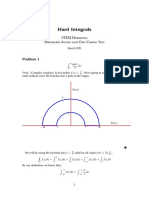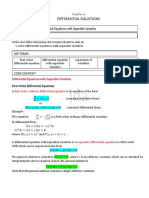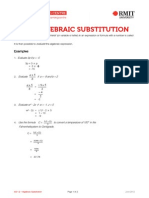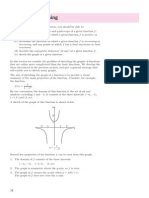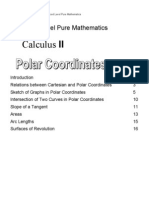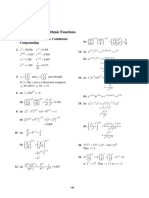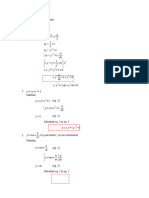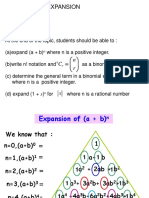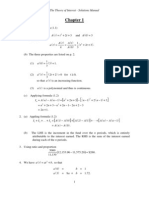Chapter 5 Applications of Definite Integral: 5-1 Area Between Curves
Chapter 5 Applications of Definite Integral: 5-1 Area Between Curves
Uploaded by
Afiqah ZainuddinCopyright:
Available Formats
Chapter 5 Applications of Definite Integral: 5-1 Area Between Curves
Chapter 5 Applications of Definite Integral: 5-1 Area Between Curves
Uploaded by
Afiqah ZainuddinOriginal Description:
Original Title
Copyright
Available Formats
Share this document
Did you find this document useful?
Is this content inappropriate?
Copyright:
Available Formats
Chapter 5 Applications of Definite Integral: 5-1 Area Between Curves
Chapter 5 Applications of Definite Integral: 5-1 Area Between Curves
Uploaded by
Afiqah ZainuddinCopyright:
Available Formats
1
dx
Chapter 5 Applications of Definite Integral
5-1 Area between Curves:
Let ) (x f y = and ) (x g y = are continuous functions such that ) ( ) ( x g x f for all x in the interval
] , [ b a . Then the area A bounded by the two curves ) (x f , ) (x g and the two lines a x = , b x = is given
by
) (x f y
top
=
= = =
b
a
bot top
b
a
dx y y dx x g x f dA A ] [ )] ( ) ( [ dA
where
= dA The area element dx y y
bot top
] [ =
The last formula can be interpreted as a sum of area ) (x g y
bot
=
Elements dA of vertical strips of height )] ( ) ( [ x g x f dx
and width dx from a x = to b x = , i.e.
= dA A
where (
) for sum.
Example: Find the area bounded by the graph of x y = 3 and 9
2
= x y .
Solution:
[ ] [ ]
= = =
b
a
bot top
b
a
dx y y dx x g x f A ) ( ) (
b a & are the intersection points.
x y = 3 , 9
2
= x y , then
9 3
2
= x x 0 12
2
= + x x , then
0 ) 3 )( 4 ( = + x x 4 = x , 3 = x
[ ] [ ]dx x x dx x x A
+ = =
3
4
2
3
4
2
) 12 ( ) 9 ( ) 3 (
6
343
)] 4 )( 12 (
2
) 4 (
3
) 4 (
[ )] 3 )( 12 (
2
3
3
3
[ ) 12
2 3
(
2 3 2 3
3
4
2 3
= +
+ =
(
x
x x
2
1
A
2
A
L
x
R
x
dy
dA
L
x
R
x
Example: Find the area bounded by the parabolas
2
x y =
2
2 x y = for 2 0 x .
Solution:
The Intersection points y
2
x y = ,
2
2 x y = , then
2 2
2 x x = 2 2
2
= x 1
2
= x 1 = x
Then
2 1
A A A + =
[ ] [ ]
= + =
2
1
2 2
1
0
2 2
4 ) 2 ( ) 2 ( dx x x dx x x A
Determine the area by integrating with respect to y :
Some region are best treated by regarding x as a function of y .
If the region is bounded by the two continuous curves ) ( y f x = , ) ( y g x = and the two lines c y = ,
d y = and ) ( ) ( y g y f for all y in the interval ] , [ d c , then the area is given by
= = =
d
c
L R
d
c
dy x x dy y g y f dA A ] [ )] ( ) ( [
where
= dA The area element dy x x
L R
] [ =
3
dA
dy
Example: Find the area bounded by the parabola
2
x y = , the line x y = 2 and 0 = y .
Solution:
Intersection points
2
x y = , x y = 2 , then
x x = 2
2
0 2
2
= + x x , then
0 ) 1 )( 2 ( = + x x 2 = x , 1 = x
Then
6
5
3
2
2
2 ] ) 2 [(
1
0
2 / 3
2 1
0
=
(
= = =
y
y
y dy y y dA A
If we need to integrate with respect to x , then the area will be given by
2 1
A A A + =
[ ] [ ]
+ =
2
1
1
0
2
0 ) 2 ( 0 dx x dx x A
6
5
2
2
3
2
1
2
1
0
3
=
|
|
\
|
+
|
|
\
|
=
x
x
x
4
5-2 Volume: Slicing Disks and Washers
Volume by Slicing (method of cross sections)
Assume a solid S of variable cross section ) (x A (the area varies with x ) from a x = to b x = .
) (x A ) (a A ) (x A ) (b A ) (x A
x
dx ] ) ( [ dx x A dV = dx
We slice the solid perpendicular to x axis. Each slice will be approximated by a cylinder of cross
section ) (x A and height dx . The volume of the slice element dV is
= = dx x A dV ) ( The volume element
The total volume can be obtained by summing the volume of all slices (
for sum), i.e.
] y
= =
b
a
dx x A dV V ) ( ) (d A
d
If the cross section ) ( y A varies with y axis from
c y = to d y = , then the volume element dV becomes
) ( [ y A
= = dy y A dV ) ( The volume element
and the total volume will be dy [
] ) ( [ dy y A dV =
= =
d
c
dy y A dV V ) ( c ) (c A
5
Example: Find the Volume of a pyramid whose base is a square with side ft h 600 = and a height is
ft w 320 = .
Solution:
The cross section area is variable of y , then the volume element becomes
dy y A dV ) ( =
where ) ( y A is a square of length x 2 at any distance y .
ft h 320 =
2 / w
x
h
y h
=
, then ) ( y A
dy x
y
y
h
y h w
x
16
15
300 )
320
320
)(
2
600
( ) )(
2
( =
= , then
y
2 2
)
16
15
300 ( 4 4 ) 2 )( 2 ( ) ( y x x x y A = = =
Then the total volume
ft w 600 =
= = =
= =
=
320
0
2
320
0
)
16
15
300 ( 4 ) ( dy y dy y A dV V
h y
y
3
320
0
3
000 , 400 , 38 )
16
15
300 ( )
3
1
)(
15
16
)( 4 ( ft y = =
6
) (x A
) (x f r =
dx
The Method of Disks (Volume of Solid of Revolution):
Solids of revolution are solids whose shapes can be generated by revolving plane region about
axis.
Assume a region bounded by the curve 0 ) ( = x f y and x axis for b x a and revolve it
about x axis. We can find the volume of this solid by slicing it perpendicular to x axis with
cross section is a circular disk of radius ) (x f y r = = .
) (x f y r = =
dx
Revolve about x axis
dx r dx x A dV
2
) ( = =
Solid of revolution
Then, the volume of slice circular disk is
dx y dx r dx x A dV
2 2
) ( = = =
The total volume of solid of revolution can be obtained by summing the volume of all slices
(
for sum), i.e.
dx x f dx r dV V
b
a
b
a
= = =
2 2
)] ( [
7
) ( y A
In a similar way, let the region is bounded by the curve 0 ) ( = y g x and y axis, for
d y c and revolve it about y axis, then
) (x g r =
r
dy dy
Revolve about the y axis Solid of revolution
Then, the volume of slice circular disk is
dy x dy r dy y A dV
2 2
) ( = = =
The total volume of solid of revolution can be obtained by summing the volume of all slices
(
for sum), i.e.
dy y g dy r dV V
d
c
d
c
= = =
2 2
)] ( [
8
dx
r
dx
dy dy
Example: Revolve the region under the curve x y = on the interval ] 4 , 0 [ about x axis and find the
volume of the resulting solid of revolution.
Solution:
= = = = =
4
0
4
0
2
4
0
2
8 ) ( dx x dx x dx r dV V
Example: Find the volume of the solid resulting from revolving the region bounded by the curve
2
4 x y = and 1 = y , 0 = x , 3 = x about y -axis.
Solution: If 0 = x , then 4 = y
y y
4
r
y x r = = 4
1
x
= = = = =
4
1
4
1
2
4
1
2
2
9
) 4 ( ) 4 (
dy y dy y dy r dV V
9
) (x f r
in
=
) (x f r
out
=
) (x g r
in
=
) (x f
) (x g
) (x f r
out
=
dx
r
dy
The Method of Washers:
If the region we revolve to generate a solid does not border on or cross the axis of rotation, the
solid has a hole in it. The cross sections perpendicular to the axis of revolution are washers instead
of disks.
If the rotation about x axis, so ) (x f r
out
= , ) (x g r
in
= , and
dx r r dV
in out
) (
2 2
= , then
= =
b
a
in out
dx r r dV V ) (
2 2
Example: Let R be the region bounded by
2
4 x y = and 0 = y . Find the volume of the solids
obtained by revolving R about each of the following: (a) the y axis, (b) the line 3 = y , (c)
the line 7 = y , (d) the line 3 = x .
Solution:
(a) The radius of the disk is y x r = = 4 , then
= = =
4
0
4
0
2 2
dy x dy r dV V
8 ) 4 ( ) 4 (
4
0
4
0
2
= = =
dy y dy y
10
dx
3
2
4 x y =
2
4 x y =
dx
y
(b) 3 =
I
r ,
2 2
7 3 ) 4 ( x x r
O
= + =
= = =
2
2
2
2
2 2 2 2 2
] 3 ) 7 ([( ) ( dx x dx r r dV V
I O
15
1472
=
(c) 7 =
O
r ,
2 2
3 ) 4 ( 7 x x r
I
+ = =
+ = = =
2
2
2
2
2 2 2 2 2
] ) 3 ( ) 7 [( ) ( dx x dx r r dV V
I O
5
576
=
11
y x = 4 y x + = 4
x r
O
=
3
x r
I
=
dx
3 / 1
y r
O
=
dy
2
y r
I
=
dy
(d) y r
O
+ = 4 3 , y r
I
= 4 3
= = =
4
0
2 2
) ( dy r r dV V
I O
= + =
4
0
2 2
64 ] ) 4 3 ( ) 4 3 [( dy y y
Example: Find the volume of the solid formed by revolving the plane region bounded by the two curves
2
y x = ,
3
x y = around: (a) the x axis, (b) the y axis, (c) the line 1 = x , (d) the
line 2 = y .
Solution:
(a) x r
O
= ,
3
x r
I
=
= =
1
0
2 2
) ( dx r r dV V
I O
14
5
] ) ( ) [(
1
0
2 3 2
=
dx x x
(b)
3 / 1
y r
O
= ,
2
y r
I
=
= =
1
0
2 2
) ( dy r r dV V
I O
5
2
] ) ( ) [(
1
0
2 2 2 3 / 1
= =
dy y y
12
1 = x
1
3 / 1
+ = y r
O
dy
1
2
+ = y r
I
2 = y
3
2 x r
O
= x r
I
= 2
(c) 1
3 / 1
+ = y r
O
, 1
2
+ = y r
I
= =
1
0
2 2
) ( dy r r dV V
I O
30
37
] ) 1 ( ) 1 [(
1
0
2 2 2 3 / 1
= + + =
dy y y
(d)
3
2 x r
O
= , x r
I
= 2
= =
1
0
2 2
) ( dx r r dV V
I O
21
4
] ) 2 ( ) 2 [(
1
0
2 2 3
= =
dx x x
13
1
r
2
r
t
r
x r =
= h
= t
h =
r =
= t
5.3 Volume by Cylindrical Shells:
Let a cylindrical shell of inner radius
1
r and outer radius
2
r and height h. The volume of the cylinder
is given by
h r r r r h r r V ) )( ( ) (
1 2 1 2
2
1
2
2
+ = =
let = = t r r ) (
1 2
The thickness shell
= =
+
r
r r
2
) (
1 2
The average radius
Then
) )( )( 2 ( ) 2 )( ( t h r h r t V = =
) 2 ( = x (the average radius) x (height) x (thickness)
=(Perimeter) x (height) x (thickness)
So, suppose that the plane region R bounded by ) (x f y = , x axis, a x = , b x = rotated about
y axis.
Cylindrical Shell of infinitesimal Thickness
The volume of a thin cylindrical shell dV of radius x r = , height ) (x f h = , and thickness dx t = is
given by
) ( ) ( ) 2 ( dx x f x dV =
=(Perimeter) x (height) x (thickness)
Then the total volume is the sum of such volumes (
for sum), i.e.
= =
b
a
dx x f x dV V ) ( ) 2 (
14
Revolving between two curves:
The region revolved about y axis.
If the plane region bounded by ) (x f y = , ) (x g y = ,
) ( ) ( x g x f , a x = , b x = revolved about y axis,
then
) )]( ( ) ( )[ 2 ( ) )( )( 2 ( dx x g x f x dx h r dV = =
=(Perimeter) x (height) x (thickness)
and the total volume becomes
= = =
b
a
b
a
dx x g x f x dx h r dV V )] ( ) ( [ ) 2 ( ) )( 2 (
The region revolved about x axis.
If the plane region bounded by ) ( y f x = , ) ( y g x = ,
) ( ) ( y g y f , c y = , d y = revolved about x axis,
then
) )]( ( ) ( )[ 2 ( ) )( )( 2 ( dy y g y f y dy h r dV = =
=(Perimeter) x (height) x (thickness)
and the total volume becomes
= = =
d
c
d
c
dy y g y f y dy h r dV V )] ( ) ( [ ) 2 ( ) )( 2 (
15
dx
y y h = ) 2 (
Example: Using the cylindrical shell method to find the volume of the solid formed by revolving the
region bounded by the graph of
2
4 x y = and the x axis about 3 = x .
Solution:
= =
2
2
) ( ) 2 ( dx h r dV V
64 ) 4 ( ) 3 ( 2
2
2
2
= =
dx x x
Example: Let R be a region bounded by the graphs x y = , x y = 2 , and 0 = y . Compute the volume
of the solid by revolving R about the lines: (a) 2 = y , (b) 1 = y , (c) 3 = x .
Solution:
Using cylindrical method
(a) Revolve about 2 = y
= =
1
0
) ( ) 2 ( dy h r dV V
3
10
] ) 2 [( ) 2 ( 2
1
0
= =
dy y y y
16
y y h = ) 2 (
1 + = y r
dx dx
1
r
2
r
2
h
1
h
dy
(b) Revolve about 1 = y
= =
1
0
) ( ) 2 ( dy h r dV V
3
8
] ) 2 [( ) 1 ( 2
1
0
= + =
dy y y y
(c) Revolve about 3 = x 3 = x
To use cylindrical shell, we would need to break
the region Rinto two pieces, since the height of
the cylindrical shells would be different for
] 1 , 0 [ x than for ] 2 , 1 [ x .
+ =
1
0
2 2
2
1
1 1
) ( ) 2 ( ) ( ) 2 ( dx h r dx h r V
4 ) ( ) 3 ( 2 ) 2 ( ) 3 ( 2
1
0
2
1
= + =
dx x x dx x x
Using the method of washers
= =
1
0
2 2
) ( dy r r dV V
I O
4 ] )) 2 ( 3 ( ) 3 [(
1
0
2 2
= =
dy y y
17
x
dx
h
Example: Using the cylindrical shells method to find the volume of the solid obtained by rotating the
region between x y = ,
2
x y = about the y axis.
Solution:
= =
1
0
) ( ) 2 ( dx h r dV V
6
] [ 2
1
0
2
= =
dx x x x
Example: Use the method of cylindrical shells to find the volume of the solid obtained by revolving the
region bounded by the curves x y =
2
,
3
x y = about 1 = x
Solution:
= =
1
0
) ( ) 2 ( dx h r dV V
30
37
] [ ) 1 ( 2
1
0
3
= + =
dx x x x
18
s
x
y
i
s
5-4 Arc Length and Surface Area
Arc Length:
By calculating the differential length element ds for the smooth curve ) (x f y = from a x = to b x = ,
then the total length will be given by
= ds s .
We first approximate the curve with several line segments ) ( s joining together as shown in the figure.
2 2 2
) ( ) ( ) ( y x s + =
2
2
2
2
) (
) (
1
) (
) (
x
y
x
s
+ =
2
2
) (
) (
1
) (
) (
x
y
x
s
+ =
By taking the limit 0 x we will have
2
2
0 0
) (
) (
1 lim
) (
) (
lim
x
y
x
s
x x
+ =
,
2
) ( 1
dx
dy
dx
ds
+ = ,
Then differential of length element dx
dx
ds
ds = is given by
dx
dx
dy
ds
(
+ =
2
) ( 1 , then dx
dx
dy
ds s
b
a
(
+ = =
2
) ( 1
Similarly,
2
) ( 1
dy
dx
dy
ds
+ = , dy
dy
dx
dy
dy
ds
ds
(
+ = =
2
) ( 1 , then
dy
dy
dx
ds s
b f
a f
(
+ = =
2
) (
) (
) ( 1
19
ds
ds
dx
y
Example: Find the arc length of the curve
2 / 3
x y = on ] 5 , 0 [ .
Solution:
2 / 3
x y = Q , then
2 / 1
2
3
x
dx
dy
= , then
5
0
2 / 3
5
0
5
0
2
2 / 1
4
9
1 )
3
2
( )
9
4
(
4
9
1
2
3
1
|
\
|
+ = + =
|
\
|
+ =
x dx x dx x s
27
335
1 ) 5 (
4
9
1
27
8
2 / 3
=
(
(
\
|
+ =
Example: Find the arc length of the curve
y
y x
2
1
6
1
3
+ = for 2 1 y .
Solution:
y
y x
2
1
6
1
3
+ = Q , then
2
2
2
1
2
1
y
y
dy
dx
= , then
dy
y
y dy
y
y s
+ + =
|
|
\
|
+ + =
2
1
4
4
2
1
2
2
2
4
1
4
1
2
1
2
1
2
1
1 1
12
17
2
1
2
1
2
1
2
1
2
1
2
1
2
2
2
2
2
=
|
|
\
|
+ =
|
|
\
|
+ =
dy
y
y dy
y
y
Surface Area:
The surface area of revolution that generated by revolving an arc around an axis can be obtained by
calculating the sum of the surface element area dA due to revolve the arc element length ds around the
axis, i.e.
= dA S
Let the arc graph ) (x f y = revolved about x axis from a x = to b x = to generate the surface of
revolution S shown in the figure.
Portion of a right circular cone
20
We decompose the surface S into small sections whose areas dA can be approximated by the surface
areas of frustum of a cone (portion of a right circular cone).
Since the surface area of the right cone with base radius r and
slant height L is given by
L r A =
Then the surface area of the frustum cone with slant height l
and upper and lower radii
1
r and
2
r can be obtained by
subtracting the two areas of the right cones shown in the figure.
i.e.
1 1 1 2 1 2
) ( l r l l r A A A + = =
l r l r r
2 1 1 2
) ( + =
Since
l l
l
r
r
+
=
1
1
2
1
, l r r l r ) (
1 2 1
= , then
l r r A ) (
2 1
+ = , ) 2 ( 2 = = l r A x (average radius) x (slant height)
where
2
2 1
r r
r
+
= is the average radius. If l is the differential ds then
1
r and
2
r would be y r = . Then
the surface area element dA will be given by
ds y dA 2 =
Then the total surface area will be given by
(
+ = = =
b
a
dx
dx
dy
x f ds y dA S
2
1 ) ( 2 2 , about x axis
Or,
(
+ =
) (
) (
2
1 2
b f
a f
dy
dy
dx
y , about x axis
If the curve revolved about y axis then the surface area becomes
= = ds x dA S 2 , about y axis
21
y
3
x y =
ds
)
`
y
x
0 2
y
2
x y =
ds
4 4 4 3 4 4 4 2 1
x
x
Example: Find the surface area of the surface that generated by revolving the curve
3
x y = for
2 0 x about x axis.
Solution:
ds y dA 2 = , dx x dx
dx
dy
ds
2 2
2
) 3 ( 1 1 + =
|
\
|
+ =
Then
dx x x dx
dx
dy
y S
+ =
|
\
|
+ =
2
0
2
0
4 3
2
9 1 ) ( 2 1 2
( ) 04 . 203 ) 2 ( 9 1
108
4 2 / 3
4
= + =
Example: Find the surface area of the surface that generated by revolving the curve
2
x y = about y
axis for 2 0 x .
Solution:
= + =
|
\
|
+ =
2
0
2
2
0
2
3
13
) 2 ( 1 2 1 2 dx x x dx
dx
dy
x S
You might also like
- Calc 2 Cheat SheetDocument2 pagesCalc 2 Cheat Sheetvgc3491No ratings yet
- Exponential and Logarithmic Functions 2Document70 pagesExponential and Logarithmic Functions 2mathworld_02040% (2)
- Hard Integrals: STEM Horizons Hrishabh Ayush and Ong Cheng YiinDocument10 pagesHard Integrals: STEM Horizons Hrishabh Ayush and Ong Cheng YiinOm GuptaNo ratings yet
- APPLICATION 1 Area Bounded by CurvesRectangular Polar Coordinates PDFDocument31 pagesAPPLICATION 1 Area Bounded by CurvesRectangular Polar Coordinates PDFJingWeybz100% (1)
- Chap 1 FUNCTIONSDocument21 pagesChap 1 FUNCTIONSscholaria.eduNo ratings yet
- Tutorial 4 Functions QuestionsDocument6 pagesTutorial 4 Functions Questionsaditya.khandelwal.2020No ratings yet
- Chap 3 Differential EquationsDocument29 pagesChap 3 Differential Equationsprakash silvarajanNo ratings yet
- Sgi 2.1 Function Operations and Composition of FunctionsDocument2 pagesSgi 2.1 Function Operations and Composition of FunctionsKayNo ratings yet
- DifferentiationDocument21 pagesDifferentiationNorhapidah Mohd Saad100% (1)
- MTHN31E - Topic 3.1 - Differential Equations With Separable Variables PDFDocument7 pagesMTHN31E - Topic 3.1 - Differential Equations With Separable Variables PDFAndreaNo ratings yet
- Powers and Roots of Complex Numbers - DeMoivre's TheoremDocument6 pagesPowers and Roots of Complex Numbers - DeMoivre's Theoremxhaikh21No ratings yet
- MT Chapter 08Document16 pagesMT Chapter 08Cornelz LiusNo ratings yet
- Math 221 Solution To ProblemsDocument16 pagesMath 221 Solution To ProblemsRyan Kristoffer NuñezNo ratings yet
- Functions PDFDocument27 pagesFunctions PDFIsrafil TamimNo ratings yet
- Mat060 Limit TheoremsDocument15 pagesMat060 Limit TheoremsFred Jr TumbagahanNo ratings yet
- Lecture 12. Derivatives of Log - FunctionsDocument5 pagesLecture 12. Derivatives of Log - FunctionsBeshoy AdelNo ratings yet
- As1.2: Algebraic Substitution: ExamplesDocument2 pagesAs1.2: Algebraic Substitution: ExamplesGanesh Bashyal PittalsNo ratings yet
- Trigonometry Formulas Are Essential ForDocument5 pagesTrigonometry Formulas Are Essential ForIna Suelen PenalesNo ratings yet
- 2 Graph SketchingDocument16 pages2 Graph Sketchingdmal88No ratings yet
- 8a. Differentiation of Exponential and Logarithmic Functions With SolutionsDocument21 pages8a. Differentiation of Exponential and Logarithmic Functions With SolutionsMatt CaparasNo ratings yet
- ODE: Elimination of Arbitrary Constant(s) : MATH 213Document10 pagesODE: Elimination of Arbitrary Constant(s) : MATH 213Anjanette ManubayNo ratings yet
- Binomial Expansion A (4037)Document9 pagesBinomial Expansion A (4037)fizza khanNo ratings yet
- Polar CoordinatesDocument18 pagesPolar CoordinatesSayemin NaheenNo ratings yet
- Indices and LogarithmsDocument2 pagesIndices and LogarithmsJo JoyNo ratings yet
- Supplementary Notes On Sketching Exponential and Logairthmic Functions PDFDocument6 pagesSupplementary Notes On Sketching Exponential and Logairthmic Functions PDFShantoshCumarasurierNo ratings yet
- Chapter1-25 9 12-MorpheusDocument148 pagesChapter1-25 9 12-MorpheushauzhiNo ratings yet
- Mathematical Induction 2015-2016Document72 pagesMathematical Induction 2015-2016SalmanAnjansNo ratings yet
- Types of PolynomialDocument12 pagesTypes of Polynomialapi-3731257No ratings yet
- Problems On Maxima and MinimaDocument5 pagesProblems On Maxima and Minimaben114No ratings yet
- Exponential and Logarithmic FunctionsDocument2 pagesExponential and Logarithmic FunctionsAnonymous RPGElSNo ratings yet
- Derivatives Formulas PDFDocument5 pagesDerivatives Formulas PDFJoe StoneNo ratings yet
- Chapter 4Document40 pagesChapter 4Asadullah MemonNo ratings yet
- X X F DX X F: Applications of Integration Plane Areas by IntegrationDocument17 pagesX X F DX X F: Applications of Integration Plane Areas by IntegrationLee Anthony ChingNo ratings yet
- Exponential Functions - Notes and WorksheetDocument35 pagesExponential Functions - Notes and WorksheetAineeNo ratings yet
- 1.1 Definitions and TerminologyDocument9 pages1.1 Definitions and TerminologyIzzati KamalNo ratings yet
- Geometrical Transformations AllDocument54 pagesGeometrical Transformations AllSaad AliNo ratings yet
- Worksheet IntegrationDocument11 pagesWorksheet IntegrationAnna_MJNo ratings yet
- Product Rule:: Uv Udv VduDocument35 pagesProduct Rule:: Uv Udv Vduمحمد شهريل محمد نورNo ratings yet
- Add MTH f4 Binder PDF October 11 2007-6-18 Am 376kDocument49 pagesAdd MTH f4 Binder PDF October 11 2007-6-18 Am 376kTifeny Seng100% (1)
- Equation Reducible To Homogeneous Differential EquationDocument3 pagesEquation Reducible To Homogeneous Differential EquationSheikh Rasel100% (1)
- Partial DifferentiationDocument8 pagesPartial DifferentiationAmirah NasirNo ratings yet
- 1c-2 Solving Linear and Quadratic Simultaneous EquationsDocument5 pages1c-2 Solving Linear and Quadratic Simultaneous Equationsriya shuklaNo ratings yet
- Module Test 3 Exercise (Important)Document4 pagesModule Test 3 Exercise (Important)preschool academyNo ratings yet
- HW 7.2 - Differential Equations - Growth and DecayDocument4 pagesHW 7.2 - Differential Equations - Growth and DecayWilliam NelsonNo ratings yet
- Higher OrderDocument2 pagesHigher OrderRatawan ArunswNo ratings yet
- Exercise 5 Non - Exact EquationsDocument1 pageExercise 5 Non - Exact EquationsAnaFarisDanialNo ratings yet
- Solved Elementary DE ProblemsDocument31 pagesSolved Elementary DE ProblemsPran ParakulNo ratings yet
- HDHDHDDocument56 pagesHDHDHDHello100% (2)
- Theory of Interest Solution, Chap 1Document13 pagesTheory of Interest Solution, Chap 1pokok_kelapaNo ratings yet
- Example 1 X y C D DX X D DX y D (Uv) Udv +vdu Dy DX y (6x) Dy DX Dy DXDocument4 pagesExample 1 X y C D DX X D DX y D (Uv) Udv +vdu Dy DX y (6x) Dy DX Dy DXNANIE BUENONo ratings yet
- Gradient & Area Under GraphDocument12 pagesGradient & Area Under GraphKugahn AesenNo ratings yet
- Differential Equation - Homogeneous Differential - Lecture - Sep2021Document16 pagesDifferential Equation - Homogeneous Differential - Lecture - Sep2021Miggy BaltazarNo ratings yet
- QuestionsDocument7 pagesQuestionsAngelo ColendresNo ratings yet
- C4 Integration WorksheetDocument25 pagesC4 Integration WorksheetMaidah YaqoobNo ratings yet
- Unit5 HPPDocument29 pagesUnit5 HPPRanjan NayakNo ratings yet
- Biology CellsDocument12 pagesBiology CellsGift ag bruhNo ratings yet
- Pure M Ath - Geom Etric Applications of Definite Integrals: Area of Plane FiguresDocument4 pagesPure M Ath - Geom Etric Applications of Definite Integrals: Area of Plane FiguresFrancis WongNo ratings yet
- Group 11: Areas and VolumesDocument32 pagesGroup 11: Areas and VolumesLuxemberg NgNo ratings yet
- Name:: Math 142.009 Exam 3 SolutionsDocument5 pagesName:: Math 142.009 Exam 3 SolutionsАрхи́пNo ratings yet
- Tutorial 2Document2 pagesTutorial 2keldyntayeg1No ratings yet
- $Xwrqrprxv1Dyljdwlrqri0Reloh5Rerw8Vlqj - Lqhfw6Hqvru: 5th International Conference On Computer & Communication EngineeringDocument4 pages$Xwrqrprxv1Dyljdwlrqri0Reloh5Rerw8Vlqj - Lqhfw6Hqvru: 5th International Conference On Computer & Communication EngineeringAfiqah ZainuddinNo ratings yet
- Basic Concepts of Electricity - Electronics TextbookDocument2 pagesBasic Concepts of Electricity - Electronics TextbookAfiqah ZainuddinNo ratings yet
- Form 3 Chapter 1Document6 pagesForm 3 Chapter 1naza977590% (29)
- Chapter 6 (Integration Techniques) : DX X XDocument27 pagesChapter 6 (Integration Techniques) : DX X XAfiqah ZainuddinNo ratings yet
- Lecture #19: Moments of InertiaDocument19 pagesLecture #19: Moments of InertiaAfiqah ZainuddinNo ratings yet
- Lec 1 Introduction To Power ElectronicsDocument38 pagesLec 1 Introduction To Power ElectronicsAfiqah Zainuddin100% (1)


